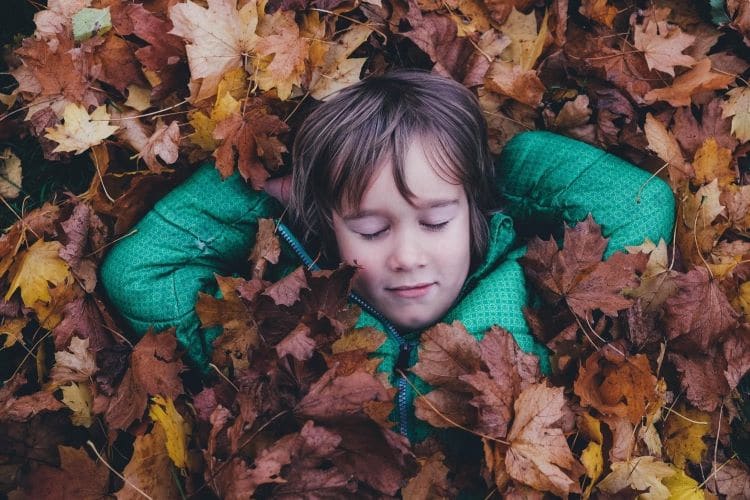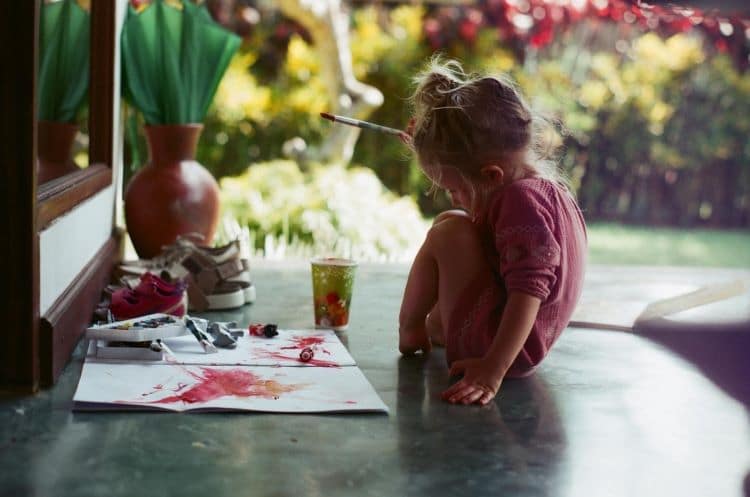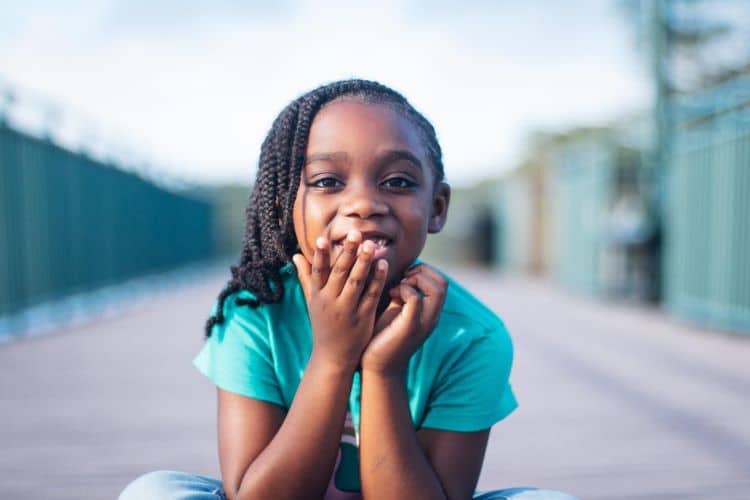Children naturally move through the world with high degrees of curiosity and openness, two fundamental principles of mindfulness. As mindfulness teachers working with children, our role is to enhance this natural presence while also helping children to navigate any challenges they encounter as they grow older
We can teach mindfulness to children in a variety of settings, whether at school, at home, in nature, or elsewhere. But regardless of the setting we find ourselves in, how can we teach mindfulness to children effectively? How will the practice benefit them? And, are there any resources or tips that might support us?

The Benefits of Mindfulness for Children
First, it can be helpful to have a clear sense of what we hope to achieve by sharing mindfulness with children. We might intuitively sense that the practice will be supportive for them, but what outcomes can we expect overtime?
Studies looking at the connection between mindfulness and the wellbeing of children show that this type of practice can:
When we are teaching mindfulness to children, we do not need to share these benefits with them explicitly. However, knowing what the science says about mindfulness can help us to explain the practice to any teachers or parents who have questions. It can also help us to keep our eye out for markers of whether or not our sessions are working.

“If the Dharma is going to truly do healing on this planet, it’s because the next generation is going to become more and more conscious.”
- James Baraz-
How to Teach Mindfulness to Children
In a sense, how children learn is not so different from how we as adults learn. Through experience, investigation, trial and error, reading, and listening, children pick up new ways of thinking and being just like we do. However, a child’s brain is far less complicated than an adult brain. Habits and beliefs are not so deeply ingrained, which can lead kids to being more open and receptive than adults. They also tend to be more playful in their learning.
This openness and playfulness can make sharing mindfulness with children an exciting experience. For instance, if we are leading a mindful eating exercise using strawberries, can you imagine the delight a child might express? Not only might mindfulness be fun for children; it should be. To make it fun and age-appropriate, consider the following tips:
Start with the basics.
Those who teach mindfulness meditation tend to have an advanced personal practice. So, it can be helpful to consciously shift gears when our audience is a group of children. When leading children through a mindfulness or meditation practice, keep it simple. Start with the basics and explain it in simple terms. Ask questions to get a sense of the maturity level in the group (and to spark engagement) and take it from there.
Leave your expectations in another room.
If we are new to teaching mindfulness to children, we might be caught by surprise when the group seems uninterested in a certain activity or struggles to settle down. Leave all expectations behind you. With kids, our session can be completely unpredictable. Let go of what you think a session should look like and remain open to whatever unfolds.
Keep it flowing and dynamic.
Both children and adults have busy minds; however, adults tend to have an easier time with silence and stillness (even if only on the outside). With kids, it is important to keep mindfulness exercises fun and flowing. For instance, if you are leading a ten-minute meditation, explore a variety of different practices (such as breathing exercises, body awareness, guided imagery, and even gentle movement).
Play with imagery and metaphors.
Mindfulness for kids tends to evoke more vibrant imagery than it does for adults. This is important because it can help to keep children engaged. For instance, when leading a breathing exercise, you might have them imagine that they are filling up a balloon in their belly. Alternatively, you might have them pretend that they are in their favourite place when practicing. This can offer a degree of comfort as they become more familiar with mindfulness.

Be prepared to improvise or change course.
Events get in the way of predictions – especially when we’re with kids. For example, you might have five activities lined up and halfway through a session realize that you’ll only have time for three. Or, you might encounter more questions and comments than you had expected. Be flexible in your approach. If you don’t make it to a particular exercise, there is always next time.
Co-facilitate if teaching mindfulness to kids is new to you – or if it is a large group.
Working with a large group of kids, particularly if you have no previous relationship the class, can be challenging. Having a second teacher to support you can be incredibly helpful. Alternatively, if you are leading in a classroom, you might be able to have the teacher support you where needed.
Make space for sharing.
Another important consideration to make is that children often need plenty of time to share. Some will be quiet and reserved while sharing, but others will have a lot to say about their experience. When sharing within the group, it can also be helpful to model what and how the kids might share. For instance, if you ask them to share how they felt about a particular meditation, you might start by saying: “When I practice this meditation, I sometimes feel restless, but often it helps me to feel calm and relaxed. What about for you?”
Ask parents or teachers if there is anything you should know about the child or group before getting started.
Lastly, it is important to get all important information that you might need before a session with kids begins. Check in with parents or teachers to find out if there are any current challenges in the class you should know about. For instance, if a child has recently lost a grandparent and has been struggling with it, it would be helpful to know this. Or, if there are kids who would do better sitting on different sides of the room, ask the teacher for their suggestions and assistance. Get as much information as you can beforehand.
Learn more about how you can certify to teach mindfulness meditation.
Fun Mindfulness Activities for Children
There is no limit to the ways in which you can explore mindfulness with children. Since mindfulness is simply the practice of bringing open, non-judgmental awareness to our experience, it can be applied to just about anything that we do. The following list is offers some suggestions of places to start if we are wondering how to teach mindfulness to kids:
Mindful eating exercise
One great exercise to explore with children is a mindful eating practice. Choose a small piece of food that is safe for all members in the group (think a berry, a cracker, or a piece of orange). Then, invite the children to explore it for one full minute with all of their senses – except for taste. Guide them to then slowly take a bite, noticing how it feels in their mouth and as it moves into their belly. Have the group share their experience at the end.
Mindful nature exploration
If you are looking for a great place to practice mindfulness with kids, look no further than the great outdoors. There are plenty of sights, sounds, smells and textures to explore in nature. Lead the group through a local forest or meadow, inviting them to mindfully contemplate what they come into contact with.
Paint your feelings
Help children get in touch with their emotions by inviting them to paint their feelings. What colors do they feel inside? What sorts of shapes do their emotions take? Invite them to explore their inner world by expressing how they feel by painting. Remind them that their artwork will look different from day to day as feelings come and go like waves.

Gratitude jar
To harness mindfulness of all we have to be thankful for, build a gratitude jar with the group you are teaching. Have each child write down one or a few things that they are grateful for. Invite them to place their small pieces of paper in a jar, shake it up, and read the statements aloud.
Teddy bear breathing
When it comes to mindfulness of breathing, a fun way to help children notice the way their breath moves through them is to have them place a teddy bear on their belly. This is to be practiced lying down. As they breathe, have them notice if the teddy bear moves. Does their belly rise and fall with each cycle? Alternatively, they could simply rest a hand on their belly.
Download 7 Meditation Scripts for Kids.
8 Resources to Help You Teach Mindfulness to Children
If you are looking for additional resources to help you share mindfulness with children, consider the following practices, scripts, and courses. These can be used directly or they might spark new ideas for how to share mindfulness with the child or group of children that you are teaching.
This free mindfulness for kids course includes a series of guided meditations and visualizations. It explores breathing practices, loving-kindness exercises, and other techniques and might serve as a starting point for understanding what the children you are working with is drawn to.
Another great mindfulness exercise for kids is this weather worksheet, which helps kids to explore their feelings in a new way. It invites children to take a personal weather report – and to realize that feelings are like the weather. They come and go; nothing stays the same forever.
To help children tune into the world around them, invite them to pay closer attention to the colors that they see. What stands out to them today? How does that color make them feel? Invite a group of children to share what they notice about the colorful world around them.
In this talk, James Baraz explores how we can share the gift of mindfulness with younger generations. This insight can help us to pass on the seed of consciousness and to awaken the goodness, kindness, and wisdom inside each child.

As mentioned previously, we can enhance mindfulness of all the blessings in a child’s life by inviting them to practice gratitude. This worksheet offers different ways to encourage gratitude in children, along with specific exercises we can explore with them.
This guided meditation for kids starts with a breathing exercise before delving into guided visualization. It is a playful way to help children become comfortable with the practice of meditation. This practice is geared towards children between six and nine years of age.
Another great way to share mindfulness with children is to explore sounds – and the silence between sounds. This worksheet offers guidance on how to teach children to pay close attention to simple sounds like the sound of a bell. It also invites children to mindfully reflect afterwards with questions such as: “What does the quiet feel like?”
Lastly, if you have your session already planned but need some music to accompany your teachings, nature sounds are a great way to inspire and soothe children. The sound of lapping waves, whistling leaves, or chirping insects can evoke feelings
of peace and ease in young ones (and in adults alike!). You can use nature sounds as a backdrop for your teachings or as a way to help them settle in as they enter the room for your session.


















